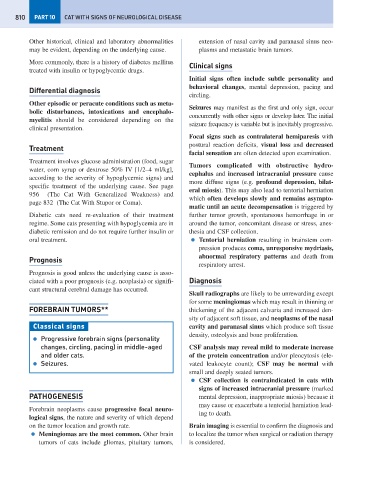Page 818 - Problem-Based Feline Medicine
P. 818
810 PART 10 CAT WITH SIGNS OF NEUROLOGICAL DISEASE
Other historical, clinical and laboratory abnormalities extension of nasal cavity and paranasal sinus neo-
may be evident, depending on the underlying cause. plasms and metastatic brain tumors.
More commonly, there is a history of diabetes mellitus
Clinical signs
treated with insulin or hypoglycemic drugs.
Initial signs often include subtle personality and
behavioral changes, mental depression, pacing and
Differential diagnosis
circling.
Other episodic or peracute conditions such as meta-
Seizures may manifest as the first and only sign, occur
bolic disturbances, intoxications and encephalo-
concurrently with other signs or develop later. The initial
myelitis should be considered depending on the
seizure frequency is variable but is inevitably progressive.
clinical presentation.
Focal signs such as contralateral hemiparesis with
postural reaction deficits, visual loss and decreased
Treatment
facial sensation are often detected upon examination.
Treatment involves glucose administration (food, sugar
Tumors complicated with obstructive hydro-
water, corn syrup or dextrose 50% IV [1/2–4 ml/kg],
cephalus and increased intracranial pressure cause
according to the severity of hypoglycemic signs) and
more diffuse signs (e.g. profound depression, bilat-
specific treatment of the underlying cause. See page
eral miosis). This may also lead to tentorial herniation
956 (The Cat With Generalized Weakness) and
which often develops slowly and remains asympto-
page 832 (The Cat With Stupor or Coma).
matic until an acute decompensation is triggered by
Diabetic cats need re-evaluation of their treatment further tumor growth, spontaneous hemorrhage in or
regime. Some cats presenting with hypoglycemia are in around the tumor, concomitant disease or stress, anes-
diabetic remission and do not require further insulin or thesia and CSF collection.
oral treatment. ● Tentorial herniation resulting in brainstem com-
pression produces coma, unresponsive mydriasis,
abnormal respiratory patterns and death from
Prognosis
respiratory arrest.
Prognosis is good unless the underlying cause is asso-
ciated with a poor prognosis (e.g. neoplasia) or signifi- Diagnosis
cant structural cerebral damage has occurred.
Skull radiographs are likely to be unrewarding except
for some meningiomas which may result in thinning or
FOREBRAIN TUMORS** thickening of the adjacent calvaria and increased den-
sity of adjacent soft tissue, and neoplasms of the nasal
Classical signs cavity and paranasal sinus which produce soft tissue
density, osteolysis and bone proliferation.
● Progressive forebrain signs (personality
changes, circling, pacing) in middle-aged CSF analysis may reveal mild to moderate increase
and older cats. of the protein concentration and/or pleocytosis (ele-
● Seizures. vated leukocyte count); CSF may be normal with
small and deeply seated tumors.
● CSF collection is contraindicated in cats with
signs of increased intracranial pressure (marked
PATHOGENESIS mental depression, inappropriate miosis) because it
may cause or exacerbate a tentorial herniation lead-
Forebrain neoplasms cause progressive focal neuro-
ing to death.
logical signs, the nature and severity of which depend
on the tumor location and growth rate. Brain imaging is essential to confirm the diagnosis and
● Meningiomas are the most common. Other brain to localize the tumor when surgical or radiation therapy
tumors of cats include gliomas, pituitary tumors, is considered.

